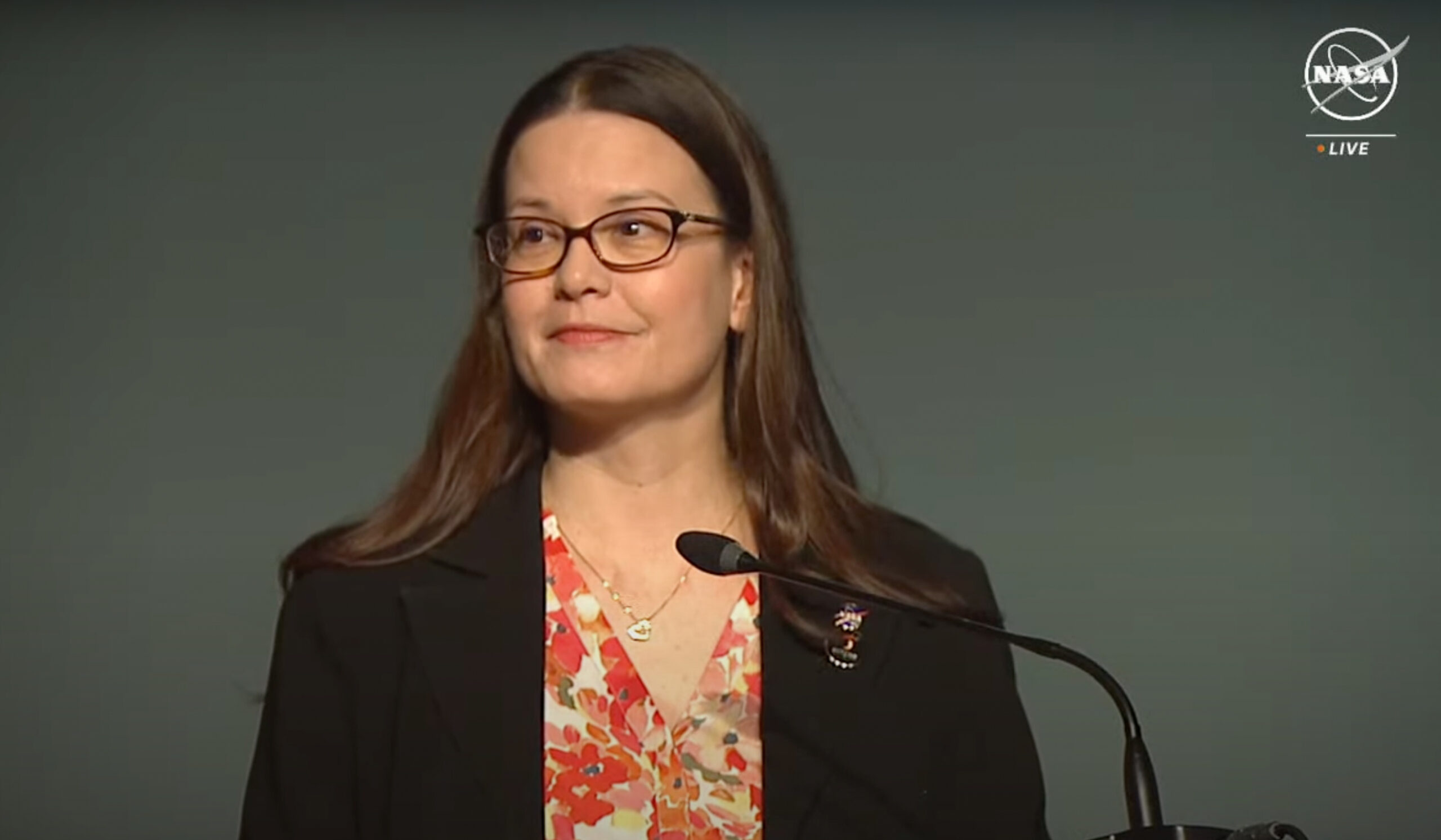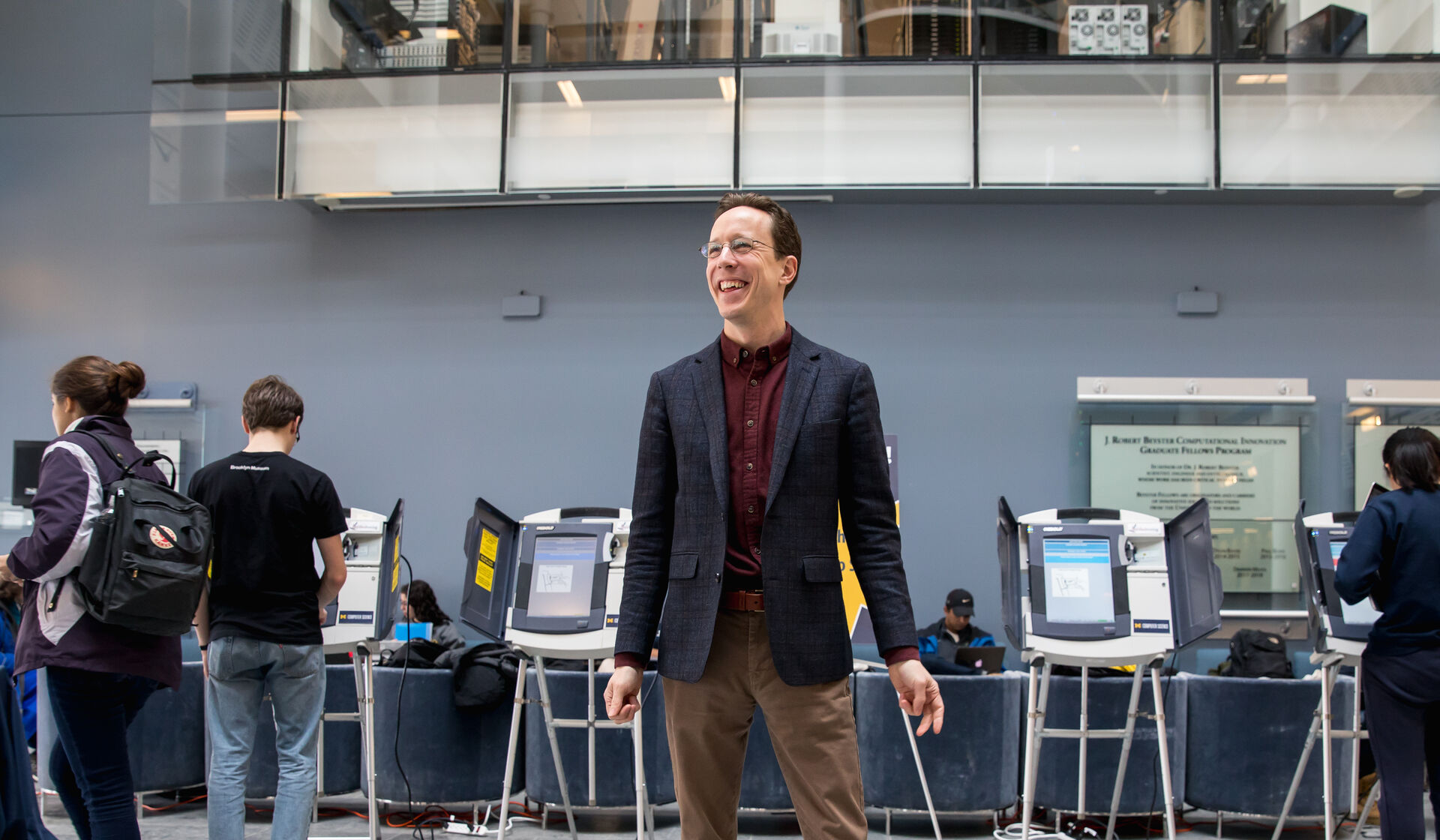Kelly Korreck, ’99, MS’02, PhD’05, stood on the deck of the USS Yorktown, a decommissioned aircraft carrier docked in the Charleston, South Carolina, harbor on August 21, 2017. Korreck had heard that seeing a total solar eclipse was life-changing and could be addictive, but she wasn’t completely convinced. After all, as an astrophysicist, she was already quite familiar with the sun.
But the mixture of awe, fear, and inspiration she felt during the eclipse was transformative.
All day, clouds had covered the sky, fraying the nerves of eclipse chasers. But as Korreck gazed upward through her safety glasses, the clouds parted enough to reveal the moon as it slipped in front of the sun, blotting out the light. A cool breeze swept through the crowd, and the orangish glow of a sunset hovered above the horizon in every direction.
“The next second afterward, I thought, ‘Okay, when’s the next one?’” she says.
The answer in the United States: the afternoon of Monday, April 8, 2024, when the moon’s shadow will sweep from Texas to Maine. This time, Korreck’s efforts will help millions of viewers have their own exhilarating eclipse experience. As NASA’s program manager for the 2023 annular and 2024 total eclipses, she has spent the past two years preparing the public and helping NASA’s scientific research reach the broadest possible audience.
The job includes talking with reporters about why eclipses happen and the importance of eye safety, ensuring NASA’s researchers are working with communications teams to share updates about their experiments, and encouraging ordinary people to collect data for citizen science initiatives. She also leads an all-hands-on-deck public engagement effort that will send NASA representatives to libraries, schools, and museums everywhere from Kerrville, Texas, to Houlton, Maine.
“We have deputized everyone who will take a short course on the eclipse — contract specialists, project managers, scientists, engineers, outreach specialists — to share their love for NASA and science with the public,” Korreck says.
Finding Her Path
Korreck studied physics and astronomy as an undergraduate at U-M and earned her master’s and Ph.D. in space and planetary physics. Her research focuses on how shock waves generated by eruptions of plasma from the sun accelerate particles in front of them — particles that may be responsible for disrupting satellite navigation or space missions.
She conducted research at the Smithsonian Institution during graduate school and later spent 17 years working for the institution’s museums and research centers. There, she was the head of science operations and the program manager for the SWEAP Suite on the Parker Solar Probe, a data-collecting spacecraft that was the first to fly through the sun’s upper atmosphere. Another facet of the job was explaining science to the public through lectures at the Smithsonian Astrophysical Observatory as well as a seminar about astronomy research offered to members of Congress and their staff.
“It was the best job for someone who loves to learn,” Korreck says. “One day I would be focused on a rocket in the lab. The next day, I would be talking to my friend at the National Zoo about pandas. The next day I would be talking to museum conservation folks about how they identify chemical signatures in paint. This is just the joy of having a conversation at the Smithsonian: it was an interesting place to be academically and intellectually with so much to learn and so many people who are so passionate about what they do.”
Korreck loved the work but eventually teetered at the edge of burnout. Two years after the Parker Solar Probe launched, the pandemic forced the cancellation of all travel and public engagement activities. Korreck realized her favorite parts of the job, both in and out of the lab, had disappeared. She took a couple of months off, reflecting in a cabin in the woods (“a little bit Thoreau-like,” she says), and spending time with her family.
“I was trying to figure out what really drove me: What was I going to focus on that was going to keep passion and excitement alive?” she says.
Two answers emerged: study space weather, and mentor women and others who have been marginalized in science. Fortuitously, she found an opportunity at NASA to pursue both interests and returned to work with a renewed sense of purpose. Korreck works with the space weather group and is the designated federal officer for the Space Weather Council, which advises NASA on space weather activities. In addition to helping establish a community mentorship program, she launched Korreck Retreats, focused on helping women in STEM “live a life they love.” A trained yoga teacher, Korreck helps clients carve out time to think strategically about their goals from a calm place.
Working with other women in science has, for Korreck, underscored the importance of having a supportive community.
“Successful women in science normally have another woman they know they can count on,” she says, both to cheer for one another’s success and to keep apparent failures in perspective. For Korreck, that person is her former roommate and grad-school officemate Sue Lepri, ’99, MS’01, PhD’04, now the director of the Space Physics Research Laboratory at U-M.
“Science has a lot of stereotypes of the lone wolf and brilliant genius — as though Albert Einstein was all alone and just came up with these ideas,” Korreck says. “But that’s not really how it works. Things are much more collaborative. That’s where we’re trying to change the narrative: that science is a collaborative and collective experience.”
On April 8, Korreck will be in Cleveland, Ohio, conducting outreach on behalf of NASA. There, she’ll revel in her second total solar eclipse while helping others experience their first.
“I’m really excited to see other people excited,” she says. “Seeing your first eclipse or 10th eclipse is exhilarating. There are things you anticipate, and they don’t live up to that level of anticipation — but total eclipses do.”
Korreck's eclipse tips:
Choose a viewing location — inside the path of totality! — where you have an unobstructed view of the sun.
Plan ahead. Bring eclipse glasses that meet the ISO 12312-2 standard or make a pinhole camera. Book hotel reservations and pack extra food, water, and gas in anticipation of heavy post-eclipse traffic.
Enjoy the full-body experience that is the eclipse. “It’s visual, but it’s also sounds, it’s feelings, it’s being with the people around you,” Korreck says.
Robyn Ross is a freelance journalist based in Texas.





